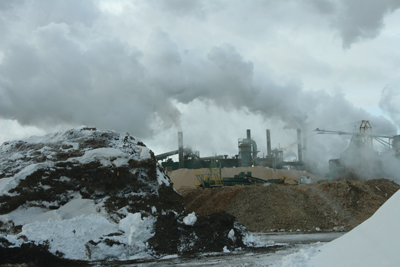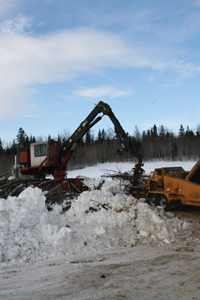
Early Adopters
August 20, 2010
By Martine Frigon
Harvesting forest residues for biomass means new hope for many sawmill owners and contractors, and many such projects have been announced recently. However, some four years ago, before this strong tendency to develop diversification strategies, an idea was born in the minds of the leaders of two organizations in eastern Quebec:
Harvesting forest residues for biomass means new hope for many sawmill owners and contractors, and many such projects have been announced recently. However, some four years ago, before this strong tendency to develop diversification strategies, an idea was born in the minds of the leaders of two organizations in eastern Quebec: the Groupement forestier de l’Est du Lac Témiscouata and Norampac. That idea now represents a supply of more than 23,000 tonnes of forest residues to fuel Norampac’s corrugated fibreboard plant in Cabano, Quebec.
 |
|
| Norampac-Cabano’s yard is filled with piles of biomass waiting to fuel the boilers that make process steam for the 220,000 tonnes/year of corrugated fibreboard.
|
The bulky residue, comprising unusable branches and other harvesting waste, is recovered and used to produce the process steam required for Norampac-Cabano’s operations. It supports the production of 220,000 tonnes/year of corrugated fibreboard. Harvested on Crown lands within a radius of approximately 100 kilometres, this forest biomass supplies the plant’s two boilers.
“Beyond 100 kilometres, the project would not be very green and also not really profitable,” says Clarence Dubé, Norampac-Cabano’s supply manager. “We do not want to move semi-trailers long distances, as we will not save on CO2,” he continues. With this thought uppermost in their minds, the plant’s leaders, in the spring of 2006, bought a 9,000-hectare woodlot located in the neighbouring county of Kamouraska.
Although the partnership between Norampac-Cabano and Groupement forestier de l’Est du Lac Témiscouata, a group of foresters and woodlot owners, began more than four years ago, the association was accredited in 2009 by the Quebec Department of Natural Resources and Wildlife under an Action Plan regarding the harvest of forest biomass in public forests. The Groupement is mandated by the government of Quebec to harvest in Crown lands.
“We were qualified to harvest in the Timber Supply and Forest Management Agreements 01151 and 01152,” says Pierre Dumont, who is in charge of public forest operations for the Groupement. “Before that, we were involved in a pilot project.” Rights to these territories are granted to six companies: Les Bardeaux Lajoie, Tembec Matane, Groupe NBG, Felix Huard, Bégin et Bégin, and Norampac-Cabano. All of this represents 20,000 tonnes/year of biomass for Norampac-Cabano, plus another 3,000 tonnes/year collected from woodlot owners who are members of the Groupement.
Harvesting: trial and error
Harvesting the biomass and providing it to Norampac-Cabano seemed like a good concept, but the Groupement had to find an economical and effective process if the idea was to prove profitable. After many tests and improvements over the years, the leaders of the Groupement settled on two methods of harvest: cut-to-length (CTL) and full tree. Harvesting is done by four contractors hired by the organization. The teams lay out the wood residues along the forest roads, and a fifth contractor is involved in secondary processing of the residues using a Woodsman 336 waste wood chipper.
 |
|
| The Woodsman 334 chipper was customized with a conveyor feed at the mouth and a lengthened carriage plate.
|
Three of the contractors do CTL harvesting. They work with CTL harvesters and transport the wood residues by forwarder. This method requires care to avoid contamination, says Pierre Dumont, who is in charge of public forest operations for the Groupement. “With the forwarder, the operators must be careful not to collect too much rock and dust because such material would cause problems for the chipper. This is what we have learned from experimentation,” says Dumont. Born, raised, and living in Dégelis, Dumont graduated as a forest technician from Cégep of Sainte-Foy in 1981 and has worked for the Groupement since 1987.
Rosaire Laplante is one of the three contractors who specialize in CTL harvesting. He owns two harvesters, a Tigercat 845D and an 845C, both fitted with Logmax 7000 harvesting heads. He also has a Rottne Rapid 16-tonne forwarder.
Les Chantiers du lac, another company, operates with two Tigercat models 845B and 860B, also with Logmax 7000 harvesting heads, and a John Deere 1110D forwarder. Lionel Rousseau, the third CTL contractor, uses a Tigercat 822 harvester as well as a Valmet 425 harvester. Both of those machines are equipped with Logmax 7000 harvesting heads. Rousseau’s company also uses two Eco Log forwarders, models 547 and 564.
In the full-tree operation, Berthier Beaulieu uses a Prentice 630 feller buncher and a Gilbert 1252 feller head, two John Deere 748G and 738G skidders, and two John Deere 790E and 2054 delimbers equipped with Propac delimber models 613 and 453.
Meanwhile, Camille Beaulieu works along Highway 185, processing wood residues left after the construction of the road. Living in Packington, Quebec, he is the contractor in charge of the operations, using a Woodsman 334 wood chipper. The Groupement purchased the chipper new in 2006.
Having launched his own business 10 years ago, Beaulieu was formerly an operator. His team is made up of his brother Lucien, and Marc-Andre Picard, a young man who has just turned 20. “There are more restrictions when you use a chipper, compared to a grinder: We have to check carefully to be sure no rocks are introduced into the machine because that would slow down our production,” Beaulieu explains. “A full load made by this chipper weighs 34 tonnes in the semi-trailer and will take one and a half hours to process,” he adds.
Pierre Dumont considers this period of time much too long. “We discovered that the John Deere 375-hp engine was too small for our needs. It just was not strong enough and limited our productivity.” He says that the Groupement has purchased a second machine with a more powerful engine, a 30/36A NCL Morbark whole-tree chipper.
Beaulieu also has a 1986 Prentice loader that has recorded 10,000 hours of use, the engine of which was rebuilt in 2009. The company’s equipment also includes two semi-trailers and two Western Star trucks. As one loaded semi-trailer is in transit towards Norampac-Cabano, the other is being loaded by the chipper.
Supplying Norampac
The partnership between Norampac and the Groupement took place for purely economic reasons. “We started when the price of fuel increased dramatically,” explains Luc Pelletier, director of Norampac-Cabano. At that time, the plant was using three boilers. The main boiler, made by Volcano, was installed in 1981. It was equipped with a Wellons-type biomass combustion chamber and had a capacity of 65,000 lbs/hour of steam. The other two boilers had a capacity of 80,000 lbs/hour each and were fuelled by number 6 oil. The proportion of emissions then was 38% from wood residues and 62% from heavy oil.
The purchase and installation of a new Groupe Simoneau boiler in 2004, an investment of $6.8 million, made it possible to reduce the CO2 emissions from fuel oil and save on energy costs. This new boiler has a capacity of 100,000 lbs/hour of steam and is equipped with a combustion chamber developed by Combustion Expert, a firm located in Trois-Rivières, Quebec. With the two biomass boilers, the management has noted a reduction of more than 90,000 tonnes/year of CO2 emissions from fossil fuels. “We avoided 96,000 tonnes of CO2 equivalent with our two boilers in 2009. Our forecast for 2010 is 120,000 tonnes because of better boiler efficiency,” says Pelletier.
A strict boiler maintenance schedule is required to maximize the boilers’ performance. Pelletier adds that the management of ash produced during boiler operation continues to be a challenge. “Our two boilers annually burn a total of 167,000 tonnes/hour of biomass. On a daily basis, that means 473 tonnes/hour of biomass,” he says. “That means a lot of ash!”
The biomass operation has also required certain adjustments. “It requires material not exceeding 50% moisture content during winter time,” he adds. "This is the kind of research and development we do. Biomass boilers require a lot of care in supply management. We must maintain sufficient inventories according to the season and the operations of the sawmills from which we purchase our wood residues,” he concludes.
In summary, Pierre Dumont and Luc Pelletier both share the same opinion as far as this method of heating is concerned: small volumes of biomass are unprofitable, and a significant supply is a must. They smile when they read articles in the regional press throughout the province announcing that 4,000 tonnes/year and lesser volumes are proposed for projects. “We did not hold any press conferences when we started our partnership in 2004. We quite simply decided to work together and use our best efforts to be profitable!” says Pelletier. He is amused to have seen various announcements from other companies over the past two years. “With the Groupement, we simply go on!” he says.
Print this page